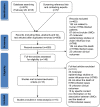Impacts of age and gender at the risk of underlying medical conditions and death in patients with avian influenza A (H7N9): a meta-analysis study
- PMID: 30233197
- PMCID: PMC6132488
- DOI: 10.2147/TCRM.S173834
Impacts of age and gender at the risk of underlying medical conditions and death in patients with avian influenza A (H7N9): a meta-analysis study
Abstract
Objective: The objective of our study was to conduct a series of analyses that examined the impacts of age and gender at the risk of underlying medical conditions (UMCs) and death in patients with influenza A (H7N9).
Methods: We began by searching for potentially relevant articles in English or Chinese before February 28, 2018. Additionally, we reviewed our own files and reference lists of articles identified by this search.
Results: The association between death and UMCs was significant in H7N9 patients, with an OR of 1.49 (95% CI: 1.24-1.78). Subgroup analyses showed that having two or more UMCs of any type (OR: 2.24; P=0.044), chronic respiratory diseases (OR: 1.81; P=0.032), and chronic cardiovascular disease (OR: 1.63; P=0.013) had an association with increased fatality in H7N9 patients. Age (60 years or older) [adjusted OR (AOR): 1.86; P=0.032] and gender (male: AOR: 1.68, P=0.006; female: AOR: 1.88, P=0.044) were significantly associated with death in H7N9 patients with UMCs compared to H7N9 patients without any UMC. Stratification analyses found statistically significant increased death in H7N9 patients with UMCs who were 60 years of age and older (AOR: 2.72; P<0.001) and gender (male; AOR=1.64; P=0.033), compared to H7N9 patients without these respective conditions.
Conclusion: Impacts of age are substantial and significant at the risk of UMCs and death in H7N9 patients. This analysis did not find a significant difference in gender comparisons. Efforts should particularly focus on reducing fatality rates in patients with combined risks from UMCs and other significant impact factor such as age (60 years or older).
Keywords: H7N9; avian influenza virus; fatality; meta-analysis; underlying medical conditions.
Conflict of interest statement
Disclosure The authors report no conflicts of interest in this work.
Figures







References
-
- Zhang F, Bi Y, Wang J, et al. Human infections with recently-emerging highly pathogenic H7N9 avian influenza virus in China. J Infect. 2017;75(1):71–75. - PubMed
LinkOut - more resources
Full Text Sources
Other Literature Sources

